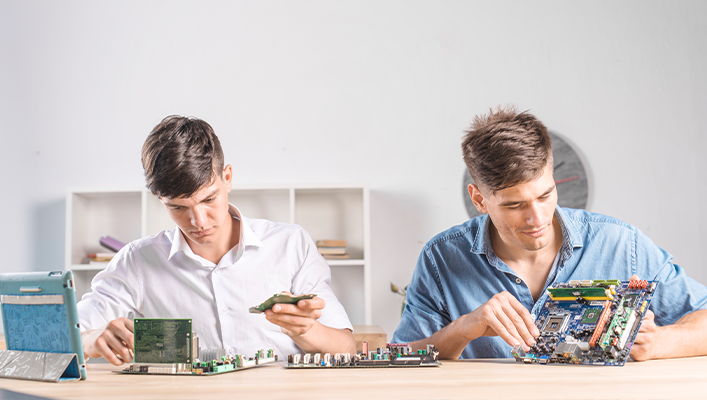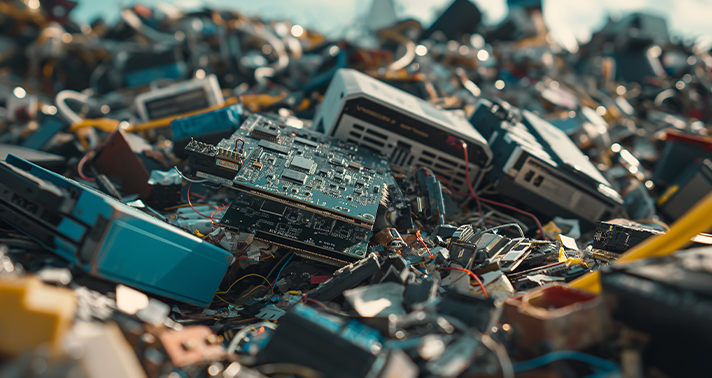Our Process
Process Flow of E-Waste Recycling
A Step-by-Step Guide to Sustainable E-Waste Management
At Advaya E-Waste Management, we follow a comprehensive and environmentally responsible approach to e-waste recycling, ensuring that valuable materials are recovered, hazardous substances are safely handled, and electronic waste is properly processed. Our e-waste recycling process is designed to minimize environmental impact, recover reusable components, and ensure compliance with global sustainability standards.
Below is an overview of the key steps in our e-waste recycling process, from collection to final disposal.
Collection of E-Waste
The first step in the e-waste recycling process is the collection of electronic waste from various sources. This includes:
Businesses
Outdated IT equipment, office electronics, and appliances.
Households
Discarded smartphones, computers, home appliances, and entertainment systems.
Institutions
Schools, hospitals, and government offices contribute electronic devices no longer in use.
At Advaya, we offer reverse logistics services to streamline e-waste collection. Our team coordinates pick-up services from your location or organizes collection drives, ensuring that all e-waste is gathered efficiently and securely.

Processing of E-Waste
After sorting, the processing of e-waste begins. This stage focuses on safely handling e-waste, with an emphasis on reducing environmental harm. Hazardous materials such as mercury, lead, and cadmium are removed and treated using specialized processes that prevent contamination of the environment. Once hazardous substances are safely isolated, the remaining components move on to further processing.
Repairing of E-Waste
Not all discarded electronics need to be recycled immediately. Many devices that are still functional or require only minor repairs can be refurbished and reused. At this stage, devices like laptops, smartphones, and computers that are in relatively good condition are evaluated for potential repair or upgrading.
Our expert technicians assess each item to determine whether it can be restored to working condition. Refurbished electronics are then sold or donated to extend their lifespan, reducing the demand for new products and helping to bridge the digital divide.

Sorting of E-Waste
Once collected, the e-waste is transported to our facility for sorting. This crucial step involves classifying electronic waste based on the type of device, material composition, and potential for reuse. The sorting process helps to determine the most suitable recycling method for each item, based on the following categories:

Reusable devices
Electronics that can be repaired and refurbished for further use.

Recyclable materials
Items that can be processed for material recovery, such as metals, plastics, and glass.

Hazardous components
Batteries, fluorescent lights, and other items containing hazardous chemicals are separated for safe handling.
Recycling
For electronics that cannot be repaired, the next step is recycling. This process involves breaking down e-waste into its core components—metals, plastics, and glass—which can be processed and repurposed for manufacturing new products. Key recyclable materials include:
- Metals: Gold, silver, copper, aluminum, and steel are extracted and reused in new electronic devices or other industries.
- Plastics: Various plastics are recovered and melted down for use in new products, such as casings for electronics or automotive parts.
- Glass: Glass from monitors and screens is processed and repurposed in construction or new display panels.
By recycling these valuable materials, we help reduce the demand for raw resources and lower the environmental footprint of manufacturing.
Dismantling is a critical phase in the recycling process where electronic devices are manually taken apart to separate components that can be recycled or reused. Skilled workers disassemble items like computers, mobile phones, and appliances into individual parts such as:
Circuit boards
Cables and wiring
Batteries
Screens
Dismantling is necessary to isolate materials that require special handling or to extract valuable metals from components like circuit boards and wiring. This process ensures that all parts are prepared for the next stage of recycling or recovery.
Once the e-waste is dismantled, the component recovery process begins. This step focuses on recovering valuable materials that can be reused in new electronics or other applications. Examples of key components recovered include:
- Precious metals: Gold, silver, platinum, and palladium, which are essential for producing new electronic devices.
- Copper and aluminum: Widely used in wiring and circuit boards, these metals are recovered and recycled.
- Rare earth elements: Critical for producing magnets, batteries, and other high-tech components, rare earth materials are carefully extracted and processed for reuse.
Recovering these valuable materials not only reduces the need for mining but also conserves natural resources and supports the circular economy by reintegrating materials into the supply chain.

After all recyclable and reusable components are recovered, any remaining materials—known as residual waste—must be safely disposed of. Residual e-waste includes non-recyclable materials or hazardous substances that require specialized disposal methods.
At Advaya, we ensure that residual e-waste is disposed of in strict compliance with environmental regulations. Hazardous materials are sent to authorized disposal facilities that follow government-approved protocols, ensuring that harmful substances do not contaminate the environment.
